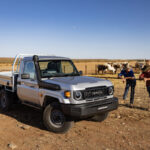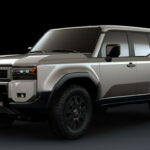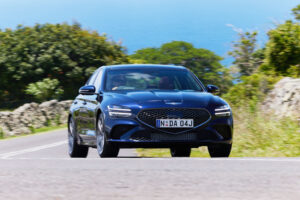
The Toyota LandCruiser 300 is the replacement for the 200 Series which had been
around for many years, over several generations in Australia. Toyota says that it has
so many improvements over its predecessors that it deserved the new title of 300.
Despite being available since mid-2021 new Toyota LandCruiser 300s are still
relatively rare on our roads largely because of supply issues. Many enthusiasts who
were aware of the arrival of the LC300 got in early and put down deposits to avoid
delivery delays.
Toyota lists the driveway price of the LandCruiser 300 GX model we tested as
$99,422. However, this may change because Toyota says “Due to extended wait
times, the final vehicle we can offer you and its price are likely to be different.”
STYLING
New Toyota LandCruiser is a large vehicle with a squared off shape which is not only
handsome to look at but also provides plenty of interior space.
The front is big and bold and makes no secret of the fact that Toyota considers this
to be a tough vehicle willing to take on the roads of Australia. Indeed, it has “Toyota”
in very large letters spread across most of the grille’s width to let others know that
this is King of the Hill Downunder. Which may seem a bit arrogant – but look at the
sales figures of Toyota over many years and you will understand why Toyota feels it
can boast.
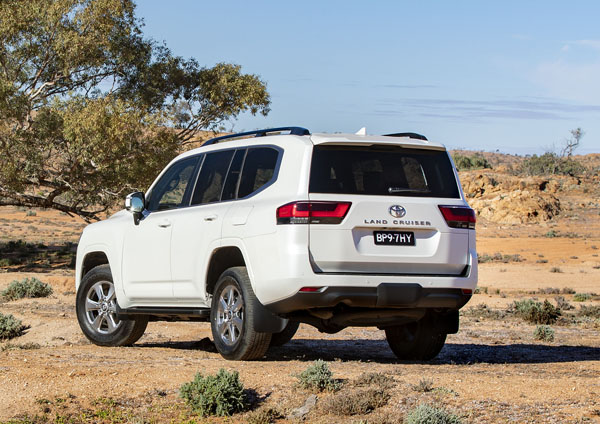
The wheel arches as squared off at the top. There’s plenty of space above the
wheels so they can take large wheel/tyre movements. We feel it looks a bit over the
top (sorry) but it works and that’s what matters.
INTERIOR
Before we talk about the interior let’s discuss how it’s not easy to get in there. The
floor sits a long way off the ground and climbing up to get in there is quite a chore.
Some models have a step to help get in, others don’t.
Our test car, the LandCruiser GX did not have steps and my wife Julie said some
(beep, beep) words about this.
I’m tall and lanky and still found it a bit of a pain. Why, oh why, Toyota did you get
this so wrong?
Some models have seven seats, others five. The GX we tested has five seats. The
rear seats on the seven seaters that we looked at in our local Toyota dealership are
rather narrow but have good legroom. If you’re considering carrying large people it
would be wise to take them along to try out the rear seats.
The finish of the interior is to a high standard with quality materials and tight margins.
It looks good and is a pleasant place to travel, all the more so when you’re spending
hour after hour there as we did on our long trek.
INFOTAINMENT
Control is through a nine-inch touchscreen with some items also offered on the
steering wheel. The audio system has six speakers. We found the quality of the
sound to be very good.
As is often the way when you’re out of residential areas the radio reception became
weak and often disappeared. As ours was a long interstate trip we tuned in to catch
local news and weather reports.
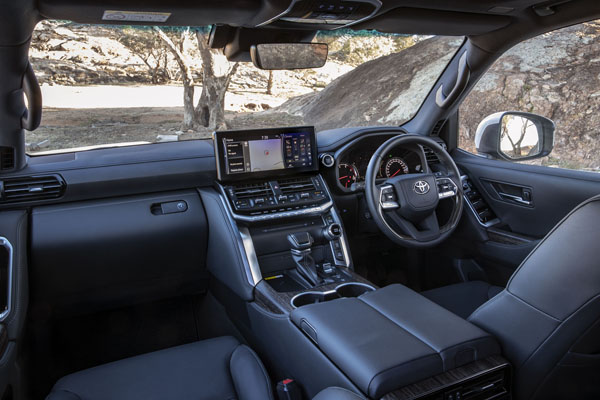
ENGINES / TRANSMISSIONS
The LandCruiser has a new-design 3.3-litre twin-turbo diesel engine. It has up to 227
kW of power and 700 Newton metres of torque, spread over a range from 1600 to
2600 rpm. See the Driving section of this test for our comments.
It drives all four wheels through a 10-speed automatic transmission with manual shift
mode.
SAFETY
Toyota LandCruiser 300 series was tested in 2022 and awarded a five-star safety
rating from ANCAP, Australasia’s independent voice on vehicle safety. It is fitted with
dual frontal, side chest-protecting and side head-protecting airbags, as well as driver
and passenger knee airbags.
The LandCruiser is able to avoid collisions and has autonomous emergency braking
tests, with collisions avoided or mitigated across all scenarios during tests.
Should everything still go wrong and you have a crash the 10 airbags will do their
best to protect all the occupants.
The LandCruiser has Toyota Safety Sense. This includes Pre-Collision Safety
system with pedestrian and daytime cyclist detection, Active Cruise Control (all
speeds), Automatic High Beam, Lane Departure Alert with brake to steer and Road
Sign Assist (speed signs only).
There are IsoFix mounting points beside each of the outer second-row rear seats.
It might seem a bit odd to talk of the reversing camera being useful when you’re out
driving in the middle of the bush. But keep in mind that when you’re in a large, bulky
vehicle parking can be tight in places where you stop for fuel and/or food in servos.
The cameras worked well on the big Toyota at times where it might have been
necessary to have someone outside it to warn of small clearances.
DRIVING
The LandCruiser we tested was the GX, the lowest cost model. Which is interesting
because car companies usually give us top line variants to try and impress us. But
the GX is obviously something Toyota is proud of and was happy to lend it to us.
We did a considerable amount of driving during our week’s test because we went
from our home on the Queensland Gold Coast to Armidale New South Wales and
back.
Total distance covered from where we picked up the LandCruiser in Brisbane to
returning it there was almost 1200 km.
As mentioned, torque is spread over an impressively wide range from 1600 to 2600
rpm. Which means that you’re in the meat of the engine’s performance all the time.
Downhill Assist Control and Hill-start Assist Control were standard in the GX but we
didn’t do any off-road driving so didn’t test them. We have no doubt they would have
worked well as Toyota has had many years in this type of driving. Toyotas are
hugely popular in the outback and in Northern Territory and we have no doubt the
company worked on them to provide the best results.
Fuel consumption on the combined urban/non-urban cycle is officially measured at
8.9 litres per 100 kilometres. During our test, which was predominantly on open
roads we averaged 8.6 L/100 km. This is an impressively low number for such a
large, heavy vehicle which was at, or perhaps even over, the speed limit (tut-tut!) a
fair bit of the time.
Steering is reasonably responsive, certainly good enough for a large vehicle where
moving people is its principal reason for being. It turned in nicely and held the road
well on the twisty bits and lets the driver know what is happening.
SUMMARY
Toyota LandCruiser 300 is an impressive vehicle that makes an excellent
replacement for the much-loved LandCruiser 200 series. It has all the latest in
technology both in safety and entertainment and looks certain to become a big seller
in its class and remain that way for many years.
RATINGS
Looks: 9/10
Performance: 7/10
Safety: 9/10
Thirst: 9/10
Practicality: 9/10
Comfort: 8/10
Tech: 8/10
Value: 8/10
AT A GLANCE
MODEL RANGE
GX: $92,681
GXL: $104,481
VX: $116,681
Sahara: $133,881
Sahara ZX: $141,481
GR-S: $140,481
Note: These prices do not include government or dealer delivery charges. Contact
your local Toyota dealer for drive-away prices.
SPECIFICATIONS (Toyota LandCruiser GX 3.3-litre turbo-diesel five-door wagon)
ENGINE:
Capacity: 3.346 litres
Configuration: V6
Maximum Power: 227 kW at 4000 rpm
Maximum Torque: 700 Nm from 1600 to 2600 rpm
Fuel Type: Diesel
Combined Fuel Cycle (ADR 81/02): 8.9 L/100km
CO2 Emissions: 235 g/km
DRIVELINE:
10-speed automatic
All-wheel drive
DIMENSIONS, WEIGHT AND CAPACITIES:
Length: 4980 mm
Wheelbase: 2860 mm
Width: 1980 mm (The GX we tested is 2000 mm wide due the fitment of a snorkel)
Height: 1950 mm
Turning Circle: 11.8 metres
Ground clearance 235 mm
Kerb Mass: 2495 kg (That’s on the GX we tested, all others are heavier depending
on model)
Fuel Tank Capacity: 110 litres – 80 litres in the main tank 30 litres in the sub-tank.
BRAKES:
Front: Ventilated disc
Rear: Ventilated disc
STANDARD WARRANTY:
Five years / unlimited kilometres




